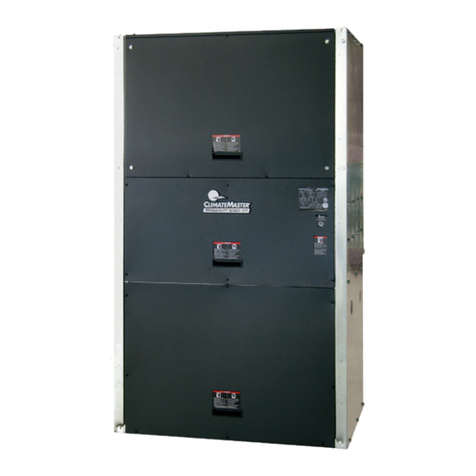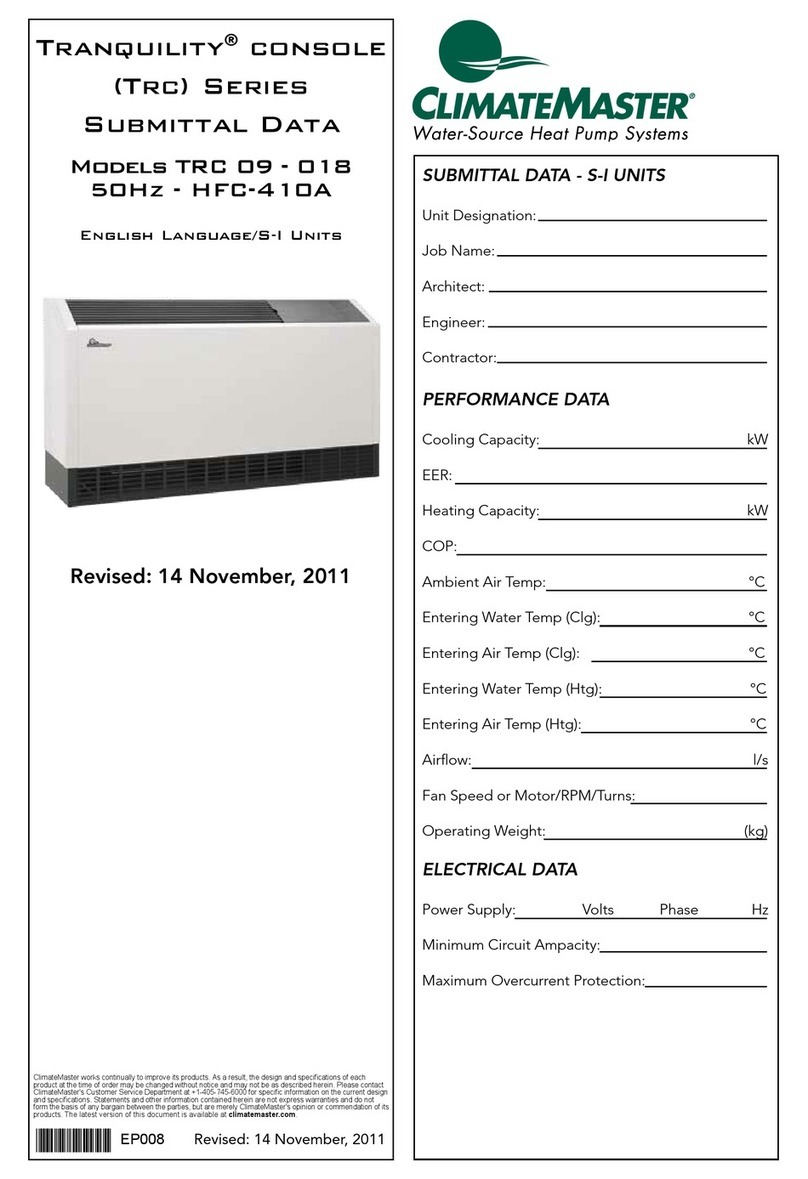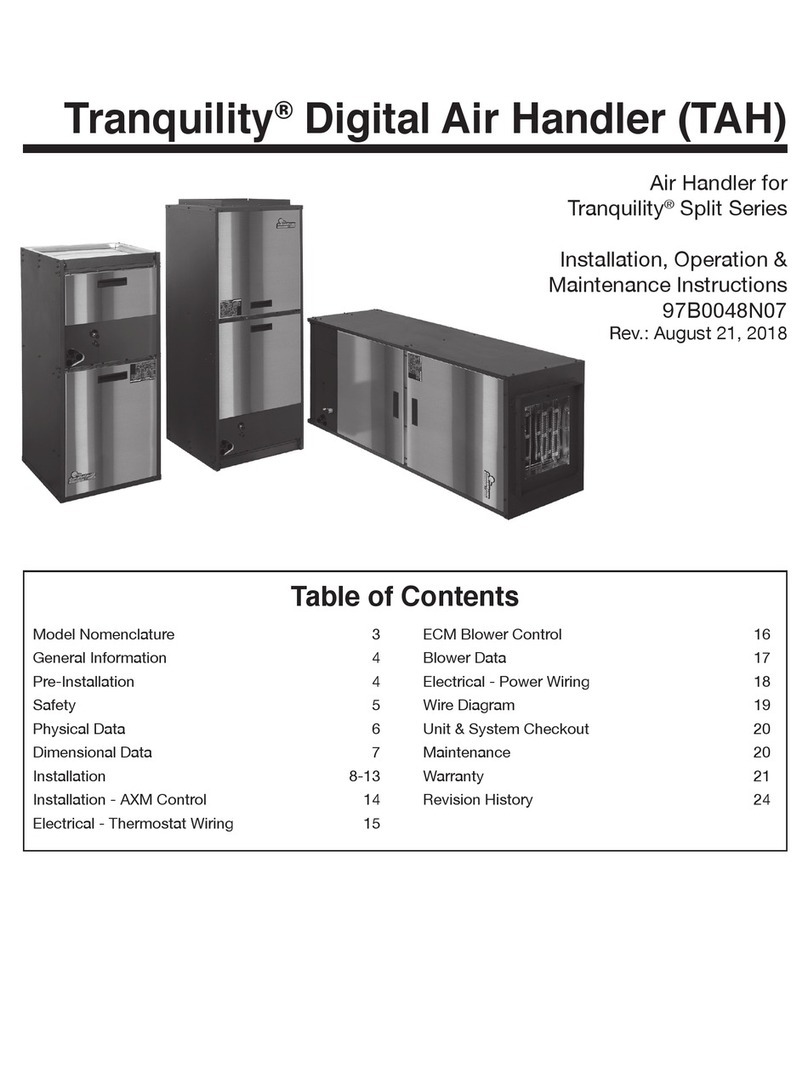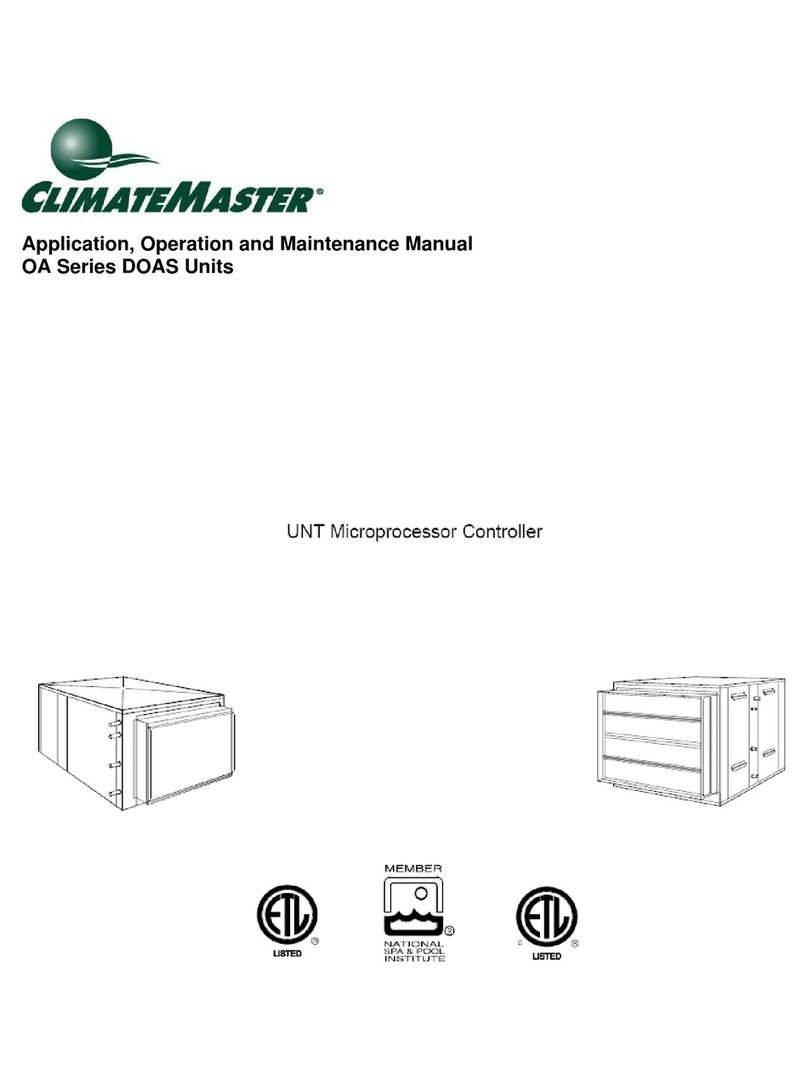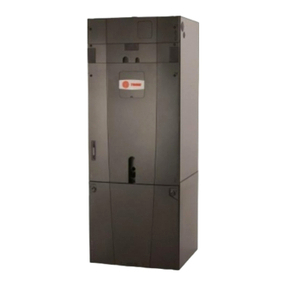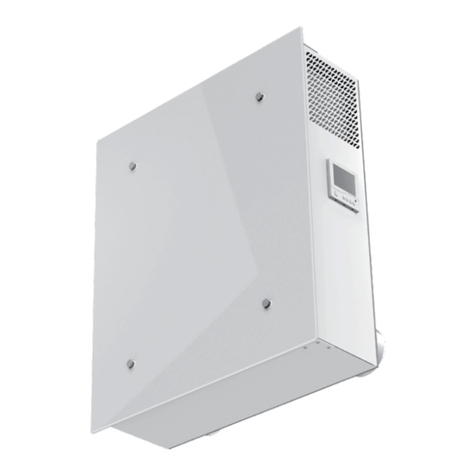ClimateMaster Tranquility Series Guide

Air Handler for
Tranquility®Split Series
Installation, Operation &
Maintenance Instructions
97B0048N07
Rev.: 2/11/13
Tranquility®Digital Air Handler (TAH)
Table of Contents
Model Nomenclature 3
General Information 4
Pre-Installation 4
Safety 5
Physical Data 6
Dimensional Data 7
Installation 8-13
Installation - AXM Control 14
Electrical - Thermostat Wiring 15
ECM Blower Control 16
Blower Data 17
Electrical - Power Wiring 18
Electric Heat Installation 19
Electric Heat Wiring 20-21
Electric Heat Staging Options 21
Wire Diagram 22
Unit & System Checkout 23
Maintenance 23
Warranty 24
Revision History 26
T
ran
q
Insta
l
M
a
i
nt
e

Tranquility®Digital Air Handler (TAH)
Rev.: 11 Feb., 2013
2Geothermal Heat Pump Systems
This page was intentionally left blank.

3
Tranquility®Digital Air Handler (TAH)
Rev.: 11 Feb., 2013
Model Nomenclature
AHT02 6
2 31 4 5 6
T = TRANQUILITY
MODEL TYPE
AH =AIR HANDLER
CONFIGURATION
026
NOMINAL CAPACITY
038
049
REVISION
064
CABINET SIZE
S
12
FUTURE USE
SIZE 026 ONLY; 18.5 WIDTH
SIZES 026, 038, 049 ONLY; 22.5 WIDTH
SIZES 038, 049, 064 ; 25.5 WIDTH
B
7
B= CURRENT REVISION
WITH AXM CONTROL
G
8
VOLTAGE
G = 208-230/60/1
M
10
CABINET OPTIONS
M = MULTI-POSITION
A
11
A
B
C
(WIDTH, INCHES)
S
9
CONTROLS
S = STANDARD
S = STANDARD
( NOTE; FIELD CONVERTIBLE TO 115v )

Tranquility®Digital Air Handler (TAH)
Rev.: 11 Feb., 2013
4Geothermal Heat Pump Systems
WARNING!
WARNING! These instructions are intended as an aid to
qualified licensed service personnel for proper installation,
adjustment and operation of this unit. Read these
instructions thoroughly before attempting installation
or operation. Failure to follow these instructions may
result in improper installation, adjustment, service or
maintenance possibly resulting in property damage,
personal injury or death.
General Information
CAUTION!
CAUTION!
Air Handler Description
ClimateMaster Tranquility®Digital Air Handlers are designed
for use with ClimateMaster indoor/outdoor split units and are
available for vertical upflow or downflow, and horizontal left
or horizontal right airflow.
•New AXM board allows 4-wire connection with
communicating split (TEP/TES) and communicating
thermostat (ATC). Airflow and accessories can be
configured on the thermostat in plain English.
•Air coils are constructed of aluminum fins bonded to
internally grooved copper tubing.
• Air coils are tested at the factory with an extensive
refrigerant leak check.
• Air coils have sweat refrigerant connections.
•Ideally suited for new installations or add on air
conditioning.
•Feature two sets of 3/4” [14.1 mm] F.P.T. Condensate
drain connections for ease of connection.
•Air Handlers are A.H.R.I. certified for system application
with ClimateMaster indoor and outdoor split units.
•Condensate drain pan is constructed of high grade, heat
resistant, corrosion free thermal-set material.
•Bi-Directional airflow eliminates the need to switch any
internal components from horizontal left to right.
•Unique drain pan design maximizes application flexibility
and condensate removal.
Inspection
Upon receipt of the equipment, carefully check the shipment
against the bill of lading. Make sure all units have been
received. Inspect the packaging of each unit, and inspect each
unit for damage. Insure that the carrier makes proper notation
of any shortages or damage on all copies of the freight bill and
completes a common carrier inspection report. Concealed
damage not discovered during unloading must be reported
to the carrier within 15 days of receipt of shipment. If not filed
within 15 days, the freight company can deny the claim without
recourse. Note: It is the responsibility of the purchaser to file
all necessary claims with the carrier. Notify your equipment
supplier of all damage within fifteen (15) days of shipment.
Storage
Equipment should be stored in its original packaging in a
clean, dry area. Store units in an upright position at all times.
Stack units a maximum of 3 units high.
Unit Protection
Cover units on the job site with either the original packaging
or an equivalent protective covering. Cap the open ends of
pipes stored on the job site. In areas where painting, plastering,
and/or spraying has not been completed, all due precautions
must be taken to avoid physical damage to the units and
contamination by foreign material. Physical damage and
contamination may prevent proper start-up and may result in
costly equipment clean-up.
Examine all pipes, fittings, and valves before installing any of
the system components. Remove any dirt or debris found in
or on these components.
Pre-Installation
Installation, Operation, and Maintenance instructions
are provided with each unit. Horizontal equipment is
designed for installation above false ceiling or in a ceiling
plenum. Other unit configurations are typically installed
in a mechanical room. The installation site chosen should
include adequate service clearance around the unit. Before
unit start-up, read all manuals and become familiar with the
unit and its operation. Thoroughly check the system before
operation.
Prepare units for installation as follows:
1. Compare the electrical data on the unit nameplate with
ordering and shipping information to verify that the
correct unit has been shipped.
2. Keep the cabinet covered with the original packaging
until installation is complete and all plastering, painting,
etc. is finished.
3. Verify refrigerant tubing is free of kinks or dents and that
it does not touch other unit components.
4. Inspect all electrical connections. Connections must be
clean and tight at the terminals.
CAUTION! DO NOT store or install units in corrosive
environments or in locations subject to temperature
or humidity extremes. Corrosive conditions and high
temperature or humidity can significantly reduce
performance, reliability, and service life.
CAUTION! CUT HAZARD - Failure to follow this caution
may result in personal injury. Sheet metal parts may have
sharp edges or burrs. Use care and wear appropriate
protective clothing, safety glasses and gloves when
handling parts and servicing.

5
Tranquility®Digital Air Handler (TAH)
Rev.: 11 Feb., 2013
Safety
CAUTION!
CAUTION! It is recommended that an auxiliary
secondary drain pan be installed under units containing
evaporator coils that are located in any area of a structure
where damage to the building or building contents may
occur as a result of an overflow of the coil drain pan or a
stoppage in the primary condensate drain piping.
The installation of water source heat pump units and all
associated components, parts and accessories which make
up the installation shall be in accordance with the regulations
of ALL authorities having jurisdiction and MUST conform to
all applicable codes. It is the responsibility of the installing
contractor to determine and comply with ALL applicable
codes and regulations.
Replacement Parts
Any replacement part must be the same as or an approved
alternate to the original part supplied. The manufacturer will
not be responsible for replacement parts not designed to
physically fit or operate within the design parameters the
original parts were selected for. When ordering replacement
parts, it is necessary to order by part number and include
the complete model number and serial number from the coil
rating plate. (See parts list for unit component part numbers.
Parts are available through the local distributor.)
WARNING!
WARNING!
WARNING!
CAUTION!
Safety
Warnings, cautions and notices appear throughout this
manual. Read these items carefully before attempting any
installation, service, or troubleshooting of the equipment.
DANGER: Indicates an immediate hazardous situation, which
if not avoided will result in death or serious injury. DANGER
labels on unit access panels must be observed.
WARNING: Indicates a potentially hazardous situation, which
if not avoided could result in death or serious injury.
CAUTION: Indicates a potentially hazardous situation or an
unsafe practice, which if not avoided could result in minor or
moderate injury or product or property damage.
NOTICE: Notification of installation, operation or maintenance
information, which is important, but which is not hazard-
related.
WARNING! All refrigerant discharged from this unit must
be recovered WITHOUT EXCEPTION. Technicians must
follow industry accepted guidelines and all local, state, and
federal statutes for the recovery and disposal of refrigerants.
To avoid leakage of compressor oil, refrigerant lines of the
compressor must be sealed after it is removed.
CAUTION! To avoid equipment damage, DO NOT use
these units as a source of heating or cooling during the
construction process. The mechanical components and
filters will quickly become clogged with construction dirt
and debris, which may cause system damage.
WARNING! The EarthPure® Application and Service
Manual should be read and understood before
attempting to service refrigerant circuits with HFC-410A.
WARNING! To avoid the release of refrigerant into the
atmosphere, the refrigerant circuit of this unit must be
serviced only by technicians who meet local, state, and
federal proficiency requirements.

Tranquility®Digital Air Handler (TAH)
Rev.: 11 Feb., 2013
6Geothermal Heat Pump Systems
Unit Physical Data
Model 026-A 026-B 038-B 038-C 049-B 049-C 064-C
Emerson ECM Fan Motor & Blower in. [cm]
Liquid I.D. 3/8 [0.95] 3/8 [0.95] 3/8 [0.95] 3/8 [0.95] 3/8 [0.95] 3/8 [0.95] 3/8 [0.95]
Suction I.D. 3/4 [1.9] 3/4 [1.9] 7/8 [2.22] 7/8 [2.22] 7/8 [2.22] 7/8 [2.22] 7/8 [2.22]
Fan Motor Type/Speeds ECM Variable
Fan Motor (hp) 1/2 1
Blower Wheel Size (Dia x W)
in. [mm] 9 x 7 [229 x 178] 12 x 10 [305 x 254]
Air Coil Dimensions (H x W)
in. [mm] 3 - 2 Row 14 x 17 [356 x 432] 3 - 2 Row 24 x 17 [610 x 432] 3 - 3 Row 24x17
[610 x 432]
Filter Standard - 1” [25mm]
Throwaway 16 x 20 [406 x 508] 20 x 20 [508 x 508] 20 x 24
[508 x 610] 20 x 20
[508 x 508] 20 x 24 [508 x 610]
Weight - Operating lbs. [kg] 80 [36] 163 [74] 173 [78] 181 [82] 180 [82] 188 [85] 198 [90]
Weight - Packaged lbs. [kg] 96 [44] 179 [81] 198 [90] 206 [93] 218 [99] 226 [103] 236 [107]

7
Tranquility®Digital Air Handler (TAH)
Rev.: 11 Feb., 2013
Unit Dimensional Data
0.0 1.6
[4.0]
3.6
[9.1] 5.8
[14.7]
5.9
[15.0]
0.0
3.7 [9.4]
4.5 [11.4]
5.6 [14.2]
6.7 [17.0]
8.5 [21.6]
Detail A
Scale 5/32
[0.4]
C
5.5
[14.0]
See Detail A
A
FD
G
H
E
J
R.A. Opening 0.625
[1.6]
0.625
[1.6] R.A. Opening 0.875
[2.2]
0.75
[1.9]
8.5
[21.6]
3.6
[9.4]
Detail A
A = Primary Drain - Vertical,
Horizontal and Downflow
Configuration
B = Secondary Drain - Vertical
and Downflow Configuration
C = Secondary Drain - Horizontal
Configuration
AB
C
Cabinet
Size
Overall Cabinet 1 2 3 4 5 6
A
Width B
Height C
Depth D E F G H J
A - Cabinet in. 18.5 44.0 22.0 14.0 14.0 2.3 2.3 4.1 4.1
cm. 47.0 111.8 55.9 35.6 35.5 5.8 5.8 10.3 10.3
B - Cabinet in. 22.0 55.0 22.0 18.0 18.0 2.1 2.1 2.1 2.1
cm. 55.9 139.7 55.9 45.7 45.7 5.2 5.2 5.2 5.2
C - Cabinet in. 25.5 59.0 22.0 18.0 18.0 3.8 3.8 2.1 2.1
cm. 64.8 149.9 55.9 45.7 45.7 9.9 9.9 5.2 5.2

Tranquility®Digital Air Handler (TAH)
Rev.: 11 Feb., 2013
8Geothermal Heat Pump Systems
Installation
The Tranquility Air Handlers are designed for upflow, horizon-
tal, and downflow applications. The coils have a dry nitrogen
holding charge and are equipped with brazing stub refriger-
ant connections for easy installation. Both models come
equipped with a factory installed TXV.
The installer should read the installation manual supplied
with the compressor section for refrigerant line set sizing,
connection procedure, and other important information per-
taining to the system installation.
The installer should:
1. Where precise forming of refrigerant lines is required, a
copper tubing bender is recommended for small diameter
tubing. One should avoid sharp bends and contact of the
refrigerant lines with metal surfaces.
2. Refrigerant lines should be protected where they pass
through the raw edges of holes.
3. Air Handler must be level for proper condensate drainage.
4. Seal the openings into the cabinet to reduce risk of con-
densate blow off from the coil.
Air Handler Installation
WARNING!
WARNING! Electric furnaces may be connected to
more than one supply circuit.
Charging the System
TAH Air Handlers are designed to match TEP/TES split
units. For correct charging, please refer to the Compressor
Section IOM.
Upflow Installation
1. Position unit on plenum box or other suitable foundation.
Provide a minimum height for proper unrestricted airflow
based on CFM requirement for each unit size.
2. If a return air duct is connected to the air handler, it must
be the same dimensions as shown in the outline drawing in
Figure 2.
3. Plenum box and unit should be isolated from the foundation
using a suitable isolating material.
4. Openings where field wiring enters the cabinet must be
completely sealed. Location of power entry is shown on the
outline drawing.
5. After ductwork connections are made, seal airtight and per
local codes.
Downflow Installation
1. Position unit on plenum box or other suitable foundation.
Provide a minimum height for proper unrestricted airflow
based on CFM requirement for each unit size.
2. If a return air duct is connected to the air handler, it must
be the same dimensions as shown in the outline drawing in
Figure 2.
3. Plenum box and unit should be isolated from the foundation
using a suitable isolating material.
4. Openings where field wiring enters the cabinet must be
completely sealed. Location of power entry is shown on the
outline drawing.
5. After ductwork connections are made, seal airtight and per
local codes.
6. The unit is then placed with the blower side down and the
coil is replaced on the coil channel supports with the drain
connections at the bottom. The unit is now in downflow
position with front access.
Position the ECM wire harness connection at the 4 to 8
o’clock position to prevent condensation from entering
motor controller.
7. If a return duct is connected to the air handler, it must be the
same dimensions as the return opening.
8. After ductwork connections are made, seal airtight and per
local codes.
Horizontal Right Installation
For maximum efficiency and customer ease of filter
maintenance, it is recommended that a properly sized
remote filter grille be installed for horizontal applications.
Airflow should not exceed the face velocity of the filter being
used. The factory installed filter should then be removed
from the unit.
1. To convert the unit to horizontal right, front access, slide the
coil out on the coil channel supports and rotate the complete
coil 180 degrees.
2. The coil is then inserted back into the cabinet on the
opposite side coil channel supports. The unit is now
horizontal right with front access.
Position the ECM wire harness connection at the 4 to 8
o’clock position to prevent condensation from entering
motor controller.
3. If the unit is suspended, it must be supported from the
bottom near both ends as well as the middle to prevent
sagging. The service access must remain unobstructed. If
the unit is supported along the length of the front and back
with rails, the air handler only needs to be suspended at
both ends. See Figure 1.
If the unit is not suspended it must be supported as
mentioned above and isolated carefully to prevent sound
transmission. Vibration isolators (purchased locally) must be
placed under the unit.
4. It is always recommended that an auxiliary drain pan be
installed under a horizontal air handler (See Condensate
Piping) to prevent possible damage to ceilings.
5. Isolate the auxiliary drain pan from the unit or from the
structure.
6. Connect the auxiliary drain line to a separate drain line
(no trap is needed in this line) and terminate according to
national and local codes.
7. If a return duct is connected to the air handler, it must be the
same dimensions as the return opening shown in the outline
drawing on Figure 2.
8. Openings where field wiring enters the cabinet must be
completely sealed.
9. After ductwork connections are made, seal airtight and per
local codes.

9
Tranquility®Digital Air Handler (TAH)
Rev.: 11 Feb., 2013
Horizontal Left Installation
1. For maximum efficiency and customer ease of filter
maintenance, it is recommended that a properly sized
remote filter grille be installed for horizontal applications.
Airflow should not exceed the face velocity of the filter being
used. The factory installed filter should then be removed
from the unit.
2. Unit is shipped from the factory in the upflow or horizontal
left configuration. Unit conversion is not required.
Conversion is required: Rotate motor to ensure connection
at the 4 to 8 o’clock position.
3. If the unit is suspended, it must be supported from the
bottom near both ends as well as the middle to prevent
sagging. The service access must remain unobstructed. If
the unit is supported along the length of the front and back,
the air handler only needs to be suspended at both ends.
See Figure 1.
4. If the unit is not suspended it must be supported as
mentioned above and isolated carefully to prevent sound
transmission. Vibration isolators (purchased locally) must
be placed under the unit.
5. It is always recommended that an auxiliary drain pan be
installed under a horizontal air handler (See Condensate
Drain Piping) to prevent possible damage to ceilings.
6. Isolate the auxiliary drain pan from the unit or from the
structure.
7. Connect the auxiliary drain line to a separate drain line
(no trap is needed in this line) and terminate according to
national and local codes.
8. If a return duct is connected to the air handler, it must be
the same dimensions as the return opening shown in the
outline drawing on Figure 2.
9. Openings where field wiring enters the cabinet must be
completely sealed. Location of power entry is shown on
the outline drawing.
10. After ductwork connections are made, seal airtight and per
local codes.
Duct Connections
The supply and return air ducts should be connected to the
unit with flame retardant duct connectors.
NOTE: No sheetmetal screws may be used to
attach return ductwork on the side.
NOTE: Any duct board return connection can be
made to the sides of the unit using tape or mastic.
Installation
Rail
Auxiliary
Drain Pan
Tranquility
EarthPure
®
27
Tranquility
EarthPure
®
27
Tranquility
EarthPure
®
27
Figure 1: Mounting Installation Options
Figure 2: Flange Attachment
Tranquility
EarthPure
®
27

Tranquility®Digital Air Handler (TAH)
Rev.: 11 Feb., 2013
10 Geothermal Heat Pump Systems
Applications
Tranquility Air Handlers can be applied in upflow, downflow,
horizontal right and horizontal left applications without
modifications. For horizontal applications, installation of an
auxiliary/secondary drain pan is required.
CAUTION!
CAUTION! For horizontal applications, the horizontal drain
pan must be located under the indoor coil. Failure to place
the pan under the coil can result in property damage.
Installation
5HWXUQ
'LVFKDUJH
TOP
DISCHARGE
5HWXUQ
'LVFKDUJH
TAH 1” to 2” Filter Rack Conversion
The unit is shipped with1” filter rack from the factory. The
conversion process is assumed that the unit is in upflow
configuration.
1. Place unit on a flat surface. Remove 2 knurled thumb knobs
that secure the filter rack door at the bottom of the unit.
2. Remove 3 screws that secure the lower filter tracks on each
side of the unit.
3. Lift and rotate the filter tracks upside down and reinstall filter
tracks and screws back.
4. Replace the filter rack door and the 2 knurled thumb knobs.
LEFT
DISCHARGE
5HWXUQ
'L
'LVFKDUJH
RIGHT
DISCHARGE
BOTTOM
DISCHARGE
5
'LV
5HWXUQ
'LVFKDUJH

11
Tranquility®Digital Air Handler (TAH)
Rev.: 11 Feb., 2013
CAUTION!
CAUTION! Installation of a factory supplied liquid line
bi-directional filter drier is required. Never install a suction
line filter in the liquid line.
CAUTION!
See compressor section IOM for refrigerant charge
information.
Line Set Installation
Figure 5 illustrates a typical installations of an air handler or
cased coil matched to an indoor compressor section. Table
A shows typical line-set diameters at various lengths. Lineset
lengths should be kept to a minimum and should always be
installed with care to avoid kinking. Line sets over 60 feet [18
meters] long are not recommended due to potential oil transport
problems and excessive pressure drop. If the line set is kinked
or distorted, and it cannot be formed back into its original
shape, the damaged portion of the line should be replaced. A
restricted line set will effect the performance of the system.
All brazing should be performed using nitrogen circulating
at 2-3 psi [13.8-20.7 kPa] to prevent oxidation inside the
tubing. All linesets should be insulated with a minimum
of 1/2” [13mm] thick closed cell insulation. All insulation
tubing should be sealed using a UV resistant paint or
covering to prevent deterioration from sunlight.
When passing refrigerant lines through a wall, seal
opening with silicon-based caulk. Avoid direct contact
with water pipes, duct work, floor joists, wall studs,
floors or other structural components that could transmit
compressor vibration. Do not suspend refrigerant tubing
from joists with rigid straps. Do not attach line set to the
wall. When necessary, use hanger straps with isolation
sleeves to minimize transmission of line set vibration to
the structure.
Installing the Indoor Coil and Lineset
Figure 3 shows the installation of the lineset and TXV to
a typical indoor coil. Braze the copper line set to the coil.
Nitrogen should be circulated through the system at 2-3 psi
[13.8-20.7 kPa] to prevent oxidation inside the refrigerant
tubing. Use a low silver phos-copper braze alloy on all brazed
connections.
Installation
Figure 3: Air Coil Connection
NOTICE! The air coil should be thoroughly washed with a
filming agent, (dishwasher detergent like Cascade) to help
condensate drainage. Apply a 20 to 1 solution of detergent
and water. Spray both sides of coil, repeat and rinse
thoroughly with water. Care should be taken not to overflow
drain pan. Wash after connecting condensate line.
Sensing Bulb
IMPORTANT: DO NOT perform any brazing with the TXV
bulb attached to any line. After brazing operations have been
completed, clamp the TXV bulb securely on the suction line
at the 10 or 2 o’clock position with the strap provided in the
parts bag. Insulate the TXV sensing bulb and suction line
with the provided pressure sensitive insulation (size 4” x 7”).
IMPORTANT: TXV sensing bulb should be located on a
horizontal section of suction line, just outside of coil box.
IMPORTANT: Always protect TXV from heat when brazing.
IMPORTANT: TXV sensing bulb is shipped unattached.
Installer must attach bulb to suction line after brazing and
cooling line for proper unit operation.
CAUTION! HFC-410A systems operate at higher
pressures than R-22 systems. Be certain that service
equipment (gauges, tools, etc.) is rated for HFC-410A.
Some R-22 service equipment may not be acceptable.
TXV (‘IN’ toward
compressor section)
Suction Line
Liquid Line
Bulb (Must be
Installed and
Insulated) Equalizer
Line
TXV has internal
check valve
LT2
Sensor

Tranquility®Digital Air Handler (TAH)
Rev.: 11 Feb., 2013
12 Geothermal Heat Pump Systems
Evacuation and Charging the Unit
LEAK TESTING -
The refrigeration line set must be pressurized
and checked for leaks before evacuating and charging the unit.
To pressurize the line set, attach refrigerant gauges to the service
ports and add an inert gas (nitrogen or dry carbon dioxide) until
pressure reaches 60-90 psig [413-620 kPa]. Never use oxygen
or acetylene to pressure test. Use a good quality bubble solution
to detect leaks on all connections made in the field. Check the
service valve ports and stem for leaks. If a leak is found, repair it
and repeat the above steps. For safety reasons do not pressurize
system above 150 psig [1034 kPa]. System is now ready for
evacuation and charging.
Condensate Drain Tubing
Consult local codes or ordinances for specific requirements.
IMPORTANT: When making drain fitting connections to the
drain pan, use a thin layer of Teflon paste, silicone or Teflon
tape and install hand tight.
IMPORTANT: When making drain fitting connections to drain
pan, do not overtighten. Overtightening fittings can split pipe
connections on the drain pan.
•Install drain lines so they do not block service access
to front of the unit. Minimum clearance of 24 inches is
required for filter, coil or blower removal and service
access.
• Make sure unit is level or pitched slightly toward primary
drain connection so that water will drain completely from
the pan (See Figure 4).
• Do not reduce drain line size less than connection size
provided on condensate drain pan.
• All drain lines must be pitched downward away from the
unit a minimum of 1/8” per foot of line to ensure proper
drainage.
• Do not connect condensate drain line to a closed or
open sewer pipe. Run condensate to an open drain or
outdoors.
• The drain line should be insulated where necessary to
prevent sweating and damage due to condensate forming
on the outside surface of the line.
• Make provisions for disconnecting and cleaning of the
primary drain line should it become necessary. Install
a 3 in. trap in the primary drain line as close to the unit
as possible. Make sure that the top of the trap is below
connection to the drain pan to allow complete drainage of
pan (See Figure 4).
• Auxiliary drain line should be run to a place where it will
be noticeable if it becomes operational. Occupant should
be warned that a problem exists if water should begin
running from the auxiliary drain line.
• Plug the unused drain connection with the plugs provided
in the parts bag, using a thin layer of Teflon paste, silicone
or Teflon tape to form a water tight seal.
• Test condensate drain pan and drain line after installation
is complete. Pour water into drain pan, enough to fill
drain trap and line. Check to make sure drain pan is
draining completely, no leaks are found in drain line
fittings, and water is draining from the termination of the
primary drain line.
'2 127 23(5$7( 81,7 :,7+287
&21'(16$7( '5$,1 75$3
81,7 0867 %( 6/,*+7/< ,1&/,1('
72:$5' '5$,1 &211(&7,21
'2 127 29(57,*+7(1 '5$,1 ),77,1*
81,7
Installation
It is always recommended that an auxiliary drain pan be
installed under a horizontally installed air handler.
Connect the auxiliary drain line to a separate drain line (no
trap is needed in this line) and terminate according to local
codes.
NOTE: DO NOT use a torch or flame near the
plastic drain pan coupling.
NOTE: DO NOT tighten the drain pipe excessively.
Support the condensate piping and traps outside
the unit to prevent strain on the drain connection.
Figure 4: Condensate Drain Trap

13
Tranquility®Digital Air Handler (TAH)
Rev.: 11 Feb., 2013
Installation
Figure 5: Typical Split/Air Handler Installation
Compressor Section
Low Voltage
Insulated
Linesets
Air pad or Extruded
polystryene
PVC Condensate
with vented trap
Power
Disconnects

Tranquility®Digital Air Handler (TAH)
Rev.: 11 Feb., 2013
14 Geothermal Heat Pump Systems
AXM Control
The Tranquility®Digital Air handler (TAH Revision B) is
equipped with a communicating AXM board to allow
communication with the communicating compressor section
(TES/TEP) and communicating thermostat (ATC).
The AXM control allows either 4-wire connection with
Communicating DXM2 board and Communicating
ATC Thermostat. It can also be connected to a non-
communicating thermostat and compressor section using
up to 9-wires (plus additional if functionality requires). Please
see Thermostat section for more details.
Low Air Temperature Sensor Installation
Tranquility
®
Digital Air Handlers are shipped with LT2 (Low
Air Temperature) sensor installed in the Air Handler (Figure
3) and connected to the AXM control. No additional action
required (do not clip the VIO wires).
Installation
Test Button
The test button puts the AXM into test mode, which
bypasses the soft start ramping profile and the blower
immediately ramps up to the nominal target speed.
FIELD SELECTABLE INPUTS
DIP SWITCHES
Note: In the following field configuration options, DIP
switches should only be moved when power is removed
from the DXM2 Control to ensure proper operation.
DIP #2: Dehumidification Mode - Provides selection of normal
or Dehumidification Fan Mode. In Dehumidification Mode, the
fan speed will be adjusted for Cooling. In Normal Mode, the
fan speed will be normal during Cooling.
On = Normal Fan Mode. Off = Dehumidification Mode
Rest of the DIP switches are not used.
ACCESSORY CONNECTION / CONFIGURATION
2 Accessory outputs on AXM board only track blower
operation.
Other accessories are connected to the DXM2 board. Please
refer to DXM2 AOM for more details.
Fan Connections
Electric Heat
Connections
9-wire connection to non-
communicating thermostat/
compressor section
4-wire connection to
communicating thermostat
4-wire
connection
to DXM2
Accessory
outputs
that track
blower
operation
LT2
Sensor Condensate
Sensor
Figure 5:
AXM Connections

15
Tranquility®Digital Air Handler (TAH)
Rev.: 11 Feb., 2013
Electrical -ThermostatWiring
Thermostat Installation
The thermostat should be located on an interior wall in a
larger room, away from supply duct drafts. DO NOT locate
the thermostat in areas subject to sunlight, drafts or on
external walls. The wire access hole behind the thermostat
may in certain cases need to be sealed to prevent erroneous
temperature measurement. Position the thermostat back
plate against the wall so that it appears level and so the
thermostat wires protrude through the middle of the back
plate. Mark the position of the back plate mounting holes
and drill holes with a 3/16” (5mm) bit. Install supplied
anchors and secure plate to the wall. Thermostat wire must
be 18 AWG wire. Wire the appropriate thermostat as shown
in Figures 6 and 7 to the low voltage terminal strip on the
ECM control board. Practically any heat pump thermostat
will work with these units, provided it has the correct number
of heating and cooling stages.
4-Wire Connection ATC communicating thermostat and
DXM2 Communicating control in Tranquility®Digital Splits
AXM control in Tranquility®Digital Air Handler allows
4-wire connection with Communicating DXM2 board and
Communicating ATC Thermostat.
Thermostat Connections
C 24V Common for Control Circuit
R 24V Supply for Control Circuit
A+ Communications (Positive)
B – Communications (Negative)
iGate™Thermostat
ATC32**
DXM2 in
Compressor
Section
Communicating
TAH with
AXM Control
R
A+
A+ B-
B-
C
R
C
24V
A+
B-
C
24V
A+
B-
C
Figure 6: 4-Wire
Connection to ATC communicating
thermostat, AXM Communicating control
and Tranquility®Digital Splits
Connection to Non-Communicating thermostat, AXM
communicating control in Tranquility®Digital Air Handler
and Tranquility® Digital Splits
Figure 7:
Connection to Non-Communicating
thermostat and AXM communicating control
in Tranquility®Digital Air Handler
Non-Communicating
2 Cool / 3 Heat Thermostat
Compressor
Compressor Stage 2
Communicating
TAH AXM Control
Y1
Y2
O
R
G
C
DH
AL1
Y1
Y2
DXM2 In
Compressor
Section
Fault LED L
Reversing Valve O
24Vac Hot R
Fan G
24Vac Common C
DH
Dehumidification
(ATP32U04 Only)
C
A+
B-
24V
C
A+
B-
24V
Thermostat Connections
C 24V Common for Control Circuit
R 24V Supply for Control Circuit
A+ Communications (Positive)
B – Communications (Negative)

Tranquility®Digital Air Handler (TAH)
Rev.: 11 Feb., 2013
16 Geothermal Heat Pump Systems
ECM Blower Control
The ECM fan is controlled directly by the DXM2/AXM
control board that converts thermostat inputs and CFM
settings to signals used by the ECM motor controller. To
take full advantage of the ECM motor features, an iGate™
communicating multi-stage thermostat should be used
(ATC32U**).
The AXM control maintains a selectable operating airflow
[CFM] for each heat pump operating mode. For each
operating mode there are maximum and minimum airflow
limits. See the ECM Blower Performance tables for the
maximum, minimum, and default operating airflows.
Airflow levels are selected using the configuration menus of
a communicating thermostat (ATC32U**) or diagnostic tool
(ACDU**). The configuration menus allow the installer to
independently select and adjust the operating airflow for each
of the operating modes. Air flow can be selected in 25 CFM
increments within the minimum and maximum limits shown in
Table 8. The blower operating modes include:
• First Stage Cooling (Y1 & O)
• Second Stage Cooling (Y1, Y2, & O)
• First Stage Cooling in Dehumidification Mode
(Y1, O, & Dehumid)
• Second Stage Cooling in Dehumidification Mode
(Y1, Y2, O, & Dehumid)
• First Stage Heating (Y1)
• Second Stage Heating (Y1 & Y2)
• Third Stage (Auxiliary) Heating (Y1, Y2, & W)
• Emergency Heating (W with no Y1 or Y2)
• Fan (G with no Y1, Y2, or W)
The ECM motor includes “soft start” and “ramp down”
features. The soft start feature is a gentle increase of motor
rpm at blower start up. This creates a much quieter blower
start cycle.
The ramp down feature allows the blower to slowly decrease
rpm to a full stop at the end of each blower cycle. This
creates a much quieter end to each blower cycle and adds
overall unit efficiency.
The ramp down feature is eliminated during an ESD
(Emergency Shut Down) situation. When the DXM2 ESD
input is activated, the blower and all other control outputs are
immediately de-activated.
The duration of the “ramp down” periods are adjustable from
0 seconds to 255 seconds. This adjustment is available
in the Aiflow Selection screen using the communicating
thermostat or configuration/diagnostics tool, see Figure 27.
Special Note for AHRI Testing: To achieve rated airflow for
AHRI testing purposes, it is necessary to change the CFM
settings to rated airflow.
AIRFLOW SELECTION
CFM
HEAT STAGE 1 600
HEAT STAGE 2 750
AUXILIARY HEAT 850
EMERGENCY HEAT 850
COOL STAGE 1 525
COOL STAGE 2 700
COOL DEHUMID 1 425
COOL DEHUMID 2 550
CONTINUOUS FAN 350
HEAT OFF DELAY 60
COOL OFF DELAY 30
PREVIOUS NEXT
Figure 27: Airflow Configuration Screen on
Communicating Thermostat

17
Tranquility®Digital Air Handler (TAH)
Rev.: 11 Feb., 2013
Blower Performance Data
Table 8:TAH Digital Standard Unit
Airflow in CFM with wet coil and clean air filter
Model Max
ESP
(in. wg)
Fan
Motor
(hp) Range Cooling Mode Dehumid Mode Heating
Mode Fan
Only
Mode
Aux/
Emerg
Mode
Stg 2 Stg 1 Stg 2 Stg 1 Stg 2 Stg 1
TAH
026 1.0 1/2
Default 700 525 550 425 750 600 350 850
Maximum 1000 800 800 600 1000 850 1000 1000
Minimum 600 450 550 400 600 450 300 700
TAH
038 0.9 1/2
Default 1050 800 850 650 1100 850 550 1350
Maximum 1500 1100 1200 900 1500 1100 1500 1500
Minimum 900 600 825 550 900 600 450 1350
TAH
049 1.0 1
Default 1400 1050 1100 850 1500 1150 700 1500
Maximum 2000 1500 1600 1200 2000 1500 2000 2000
Minimum 1200 900 1100 825 1200 900 600 1350
TAH
064 0.7 1
Default 1750 1300 1400 1050 1875 1450 875 1875
Maximum 2300 1900 2000 1500 2300 1900 2300 2300
Minimum 1500 1100 1375 1000 1500 1100 750 1500
TAH
072 0.7 1
Default 1900 1450 1650 1250 2000 1650 950 2000
Maximum 2300 2200 2000 1800 2300 2200 2300 2300
Minimum 1800 1350 1650 1250 1800 1350 900 1800
Airflow is controlled within 5% up to the Max ESP shown with wet coil

Tranquility®Digital Air Handler (TAH)
Rev.: 11 Feb., 2013
18 Geothermal Heat Pump Systems
1. These Air Handlers are shipped from the factory wired
for 230 volts. The units may be wired for 208 or 115
volts. Follow instructions on unit wiring diagram located
on blower housing and in the Service Facts document
included with the unit.
2. The selection of wire and fuse sizes should be made
according to the Minimum Branch Circuit Ampacity and the
Maximum Overcurrent Device listed on the unit nameplate.
3. Field wiring diagrams for electric heaters and unit
accessories are shipped with the accessory.
4. Wiring must conform to National and Local codes.
5. Ground unit per local codes with good safety procedures.
NOTE: If air handler is used with or without a
heater, the electrical entry hole as well as any other
cabinet penetrations must be sealed air-tight.
Wiring Instructions for 115v Conversion from 230 volt
1. Disconnect all power to the unit.
2. Disconnect Transformer primary orange wire from power
block T2 and insulate open end of wire. Connect the
white lead from transformer primary wire to power block
terminal T2. Note: (L2 will be used as Netural)
3. Remove plug in ECM power wiring harness (Fig. 9) and
Install 2 pin jumper plug provided in control box (Fig. 10).
NOTE: When supplementary heaters are installed,
inspect to insure that all packaging material has
been removed.
Electrical - PowerWiring
WARNING! Figure 9: Remove Harness Plug
Note: For 115v power only. Damage will occur to motor
with 230v power supply if 115v jumper is used.
Table 4: Electric Table (115) 208/230
WARNING! Electrical shock hazard - Lock unit disconnect
switch in open position before servicing unit. Failure
to follow this warning could result in property damage,
personal injury, or death.
Figure 10: Install Two Pin Jumper Plug
Model Fan
Motor
FLA
Fan
Motor
HP
Max
Fan
ESP
Min Circ
Amp
(120)
208/230
Total
Unit
FLA
Max Fuse/
HACR
(120)
208/230
026 (7.7) 4.3 1/2 0.5 (7.8) 4.9 (7.7) 4.3 (15) 15
038 (7.7) 4.3 1/2 0.5 (7.8) 4.9 (7.7) 4.3 (15) 15
049 (12.8) 7 1 1 (14.4) 8.6 (12.8) 7 (25) 15
064 (12.8) 7 1 1 (14.4) 8.6 (12.8) 7 (25) 15
Dual Rated Voltate: (115) 208/230
Min/Max Voltage: 115: 114/132
Min/Max Voltage: 208/230: 197/254

19
Tranquility®Digital Air Handler (TAH)
Rev.: 11 Feb., 2013
Overview
The AG Series Auxiliary Electric Heat mounts internally in
upflow (Figure 11) or downflow units and horizontal units.
Horizontal units are rated for zero clearance at the unit
and 1" clearance for first three feet of duct, vertical units
rated for zero clearance for both unit and duct. Downflow
units can not be located directly over a discharge register.
The discharge plenum must be constructed from non
combustible material. The AG electric heat contains a four
stage relay control board which activates the elements
directly via an internally wired low voltage harness. Low
voltage signals (W1 and W2) are staged from the AXM
control.
Vertical Upflow or Downflow and Horizontal Installation
1. Disconnect power to the unit
2. Remove blower access panels.
3. Clip wire-tie holding electric heat low voltage 3-wire
harness to discharge panel stiffener.
4. Remove blower mounting screws and then drop down
blower assembly as shown in Figure 12. Removal of
blower wires should not be necessary.
5. Install electric heat in discharge flange where blower
assembly has been removed using provided screws as
shown In Figure 13.
5.5 For downflow or horizontal right discharge units, the
air handler support bracket must be removed to re-
install the blower housing assembly. After re-installing
the blower housing, re-install the air handler support
bracket.
6. Re-install blower assembly, Figure 13, into electric heat
assembly using blower mounting screws. Check blower
wiring for proper wiring connections.
7. Route the low voltage harness through the provided
‘pie’ bushing and plug into electric heat control board
connector P2 as shown in Figure 18.
8. Install power conduit through unit corner post knockout
and attach conduit directly to the electric heat control
box.
9. Optional: AG**C kits only. Blower power may be supplied
from T3 & T4 CB5 breaker. Refer to wiring diagram
96B0143N01.
Electric Heat Installation
Locate electric heat assembly
on pins in discharge panel
and insert screws
Relocate blower in electric
heat assembly in same
manner
Figure 12: Blower removal
Figure 13: AG electric heat mounting and
blower re-installation
Figure 11: Typical air handler installation
Route condiut thru cabinet and
connect to electric heat control
box. Seal to eliminate air leaks on
cabinet exterior.
Low voltage control
harness is prewired
on all distributor class units.
Electric Heat
Assembly
Auxiliary electric heat
power supply knockout
opposite air coil
Disconnect (optional
refer to local code)
Air Coil

Tranquility®Digital Air Handler (TAH)
Rev.: 11 Feb., 2013
20 Geothermal Heat Pump Systems
Figure 14: Power Wiring, Dual Circuits, 15 and 20kw Figure 15: Power Wiring, Single Circuit, 15, 20kw
Wiring and Setup (all models)
1. Install power wiring and connect to power block or
circuit breakers. In 12, 15 or 20kW models two power
circuits may be used to reduce wiring and breaker
costs as in Figure 14. If a single circuit supply is
desired, install the optional single circuit accessory kit
(P/N 16B0002N02), as shown in Figure 15, that can be
obtained from your distributor.
2.
Ensure unit airflow setting is above minimum airflow rating
for the electric heat model from Table 1.
3. Check staging jumpers for the application. Typically
only 5 kW (factory setting on all models except 10kW on
20kW models) is needed for first stage electric (W1) to
minimize electric demand. This staging can be adjusted
by moving the staging jumpers as shown in Figure 17.
Whatever is jumped to P1 pin 1 will be energized on
1st stage of electric heat, and P1-2 will be energized as
stage 2 electric heat. See Table C for staging options.
4. Mark the appropriate box of the electric heat model
installed on the additional serial plate on the exterior of
the unit.
5. Turn on the power to the unit and the auxiliary
electric heat.
Auxiliary Electric Heat Start-up
Put thermostat in emergency heat mode in manual mode on
ATC/ACD (see figure #) and setpoint to high setting. Unit will
require 15-20 seconds before engaging emergency heat mode
stage 1 (W1) and then another 15-20 seconds to engage
stage 2 (W2) when in ‘Test mode’. Verify proper electric heat
operation. Exit manual mode for normal operation.
NO
Com ER1
NO
Com ER2
NO
Com ER3
NO
Com ER4
123
Tan
Ora
Factory Staging
(see Table 2)
Low Voltage Connector
(from Unit Control Board)
AG Electric Heat
Relay Board P1P2
24V
W1
W2
4
5kW (‘ER1’ 5kW & ‘ER4’ 0kW) and W2 (second stage)
will have 10kW (‘ER2 & 3’ 5kW each)
1234
Tan
Ora
P2
Side View as seen in Control Box
P1
Staging Example on a 15kW unit W1 (first stage) has
blank
Figure 17: Staging Jumpers
Figure 16: Power Wiring, 4, 5, 8, and 10kw
Electric Heat Wiring
21
2))
21
2))
3
,QDQGN:XQLWV
WZRSRZHUFLUFXLWVDUH
HPSOR\HGWRUHGXFHZLUHV
VL]HDQGFRVWRIEUHDNHUV
/
/
/
/
3
&RQGXLW
MANUAL OPERATING MODE
Y1 COMM OUTPUT OFF
Y2 COMM OUTPUT OFF
W COMM OUTPUT OFF
O COMM OUTPUT OFF
G COMM OUTPUT OFF
H COMM OUTPUT OFF
DH COMM OUTPUT OFF
ECM AIRFLOW 0
PUMP SPEED 0%
TEST MODE OFF
SELECT OPTION
PREVIOUS SELECT
Y1 COMM OUTPUT OFF
W COMM OUTPUT OFF
This manual suits for next models
8
Table of contents
Other ClimateMaster Air Handler manuals
Popular Air Handler manuals by other brands
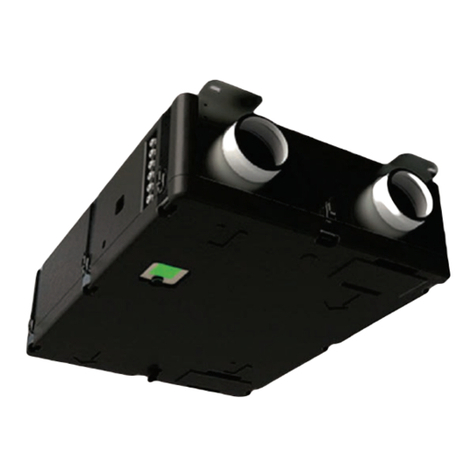
RDZ
RDZ CHR 120-FC/S Technical installation manual
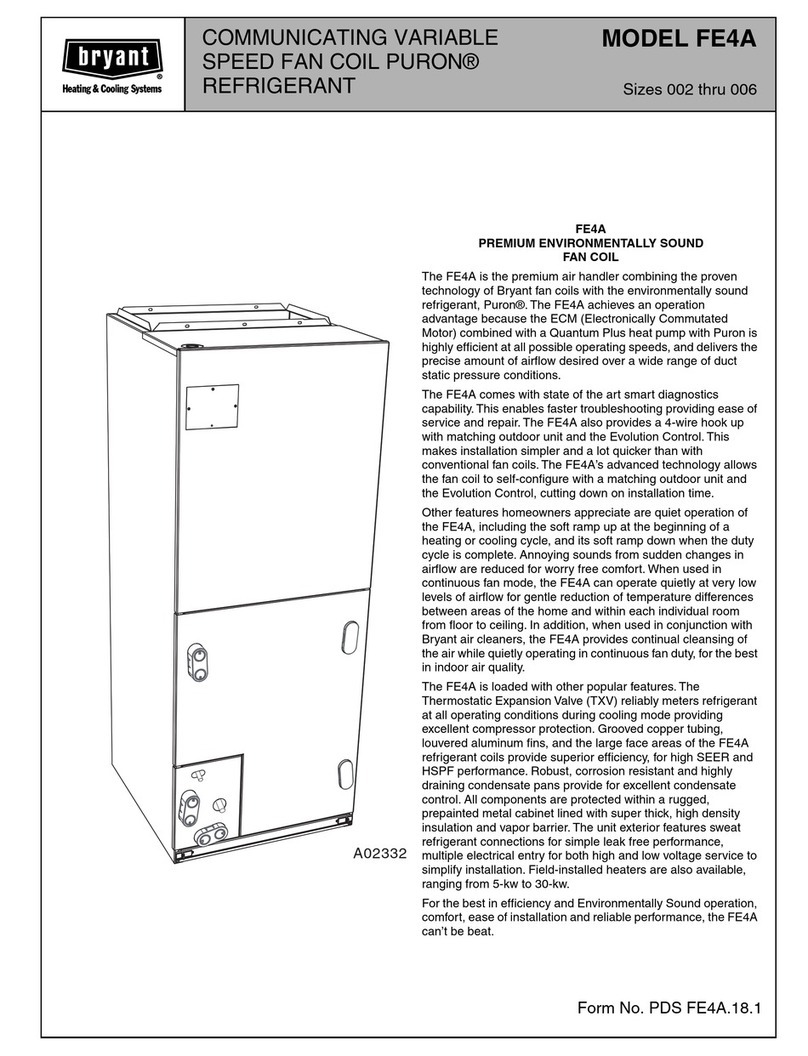
Bryant
Bryant fe4anf005 installation instructions
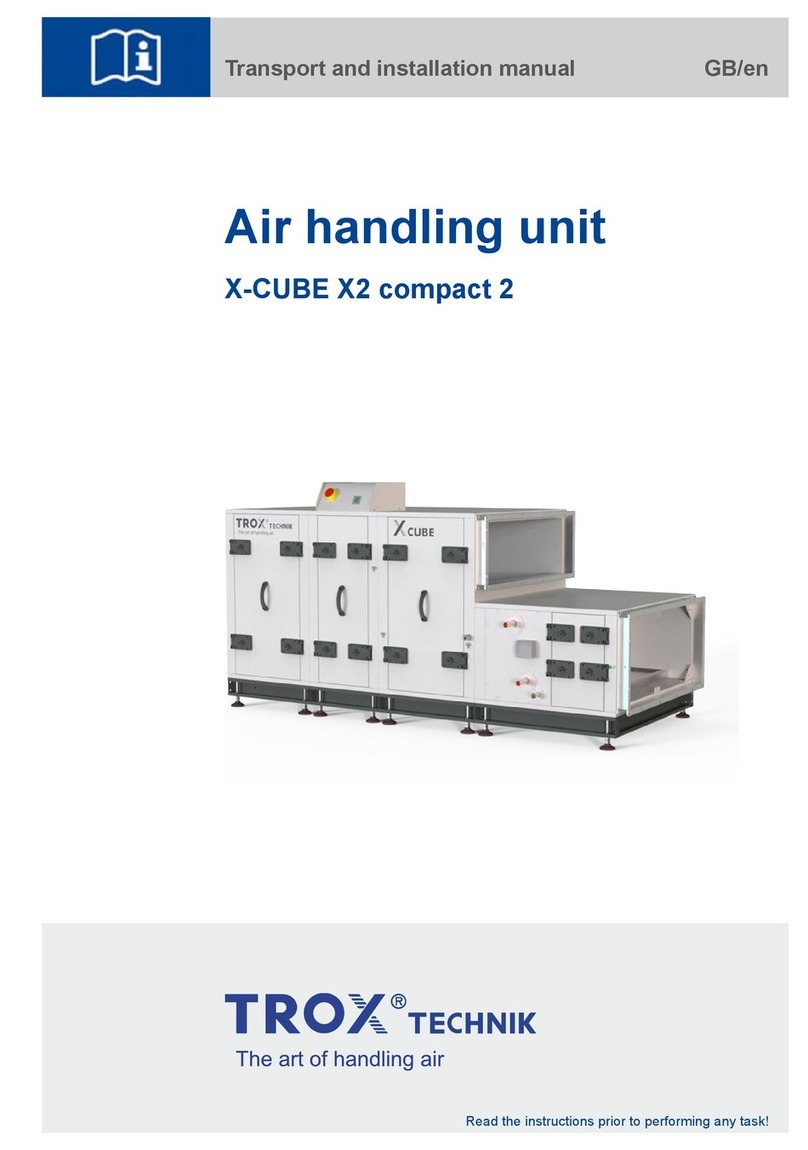
Trox Technik
Trox Technik X-CUBE X2 compact 2 Transport and installation manual
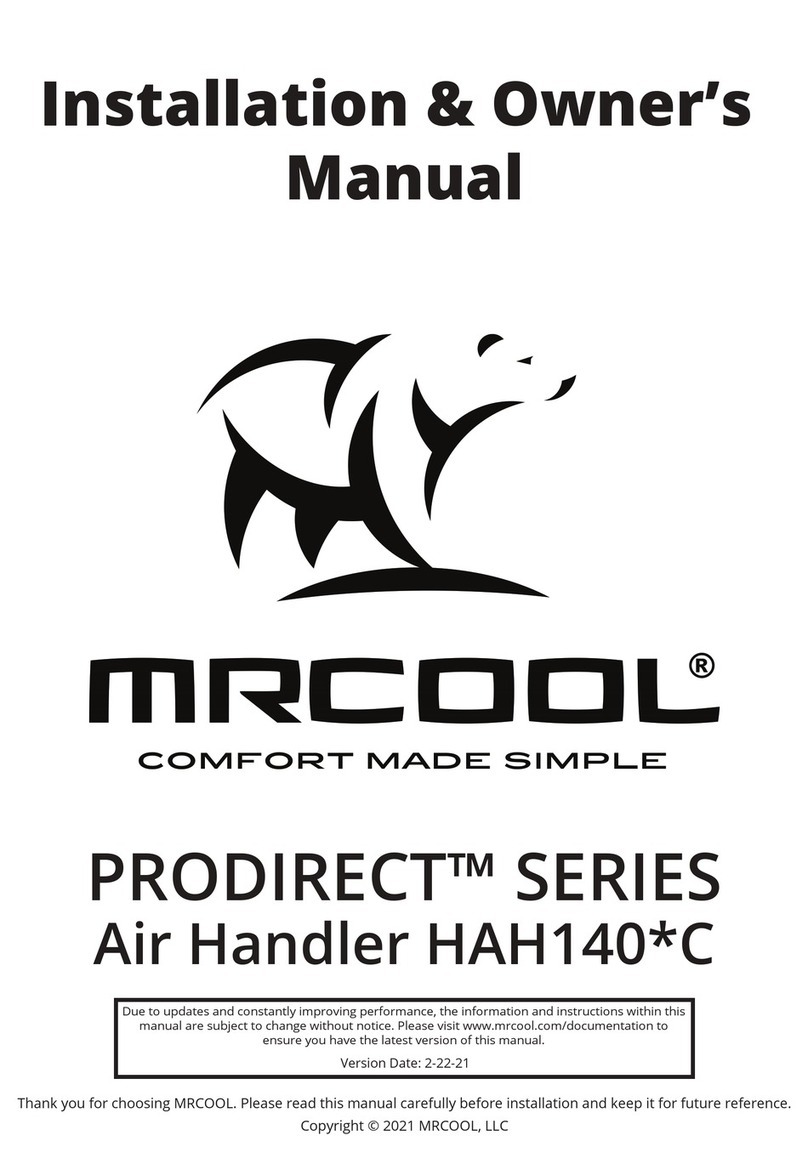
MrCool
MrCool PRODIRECT Series Installation & owner's manual
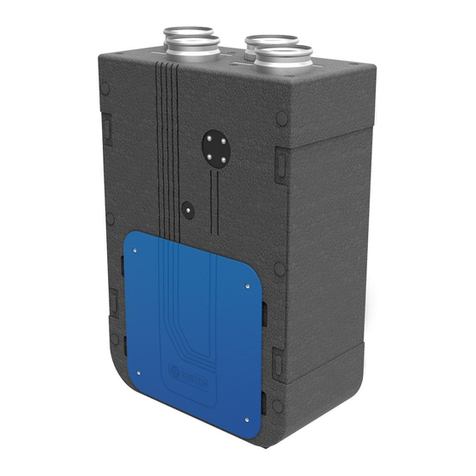
BLAUBERG
BLAUBERG Komfort EC S5B270 S14 installation guide
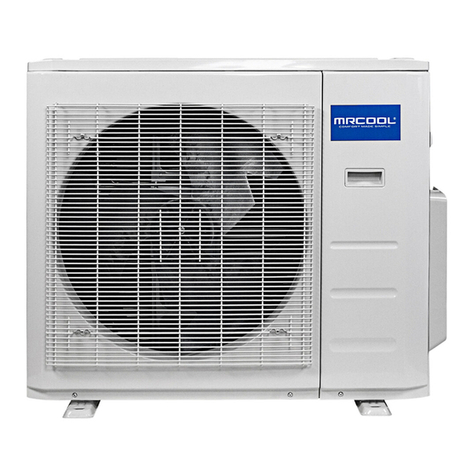
MrCool
MrCool Olympus Series Installation & owner's manual
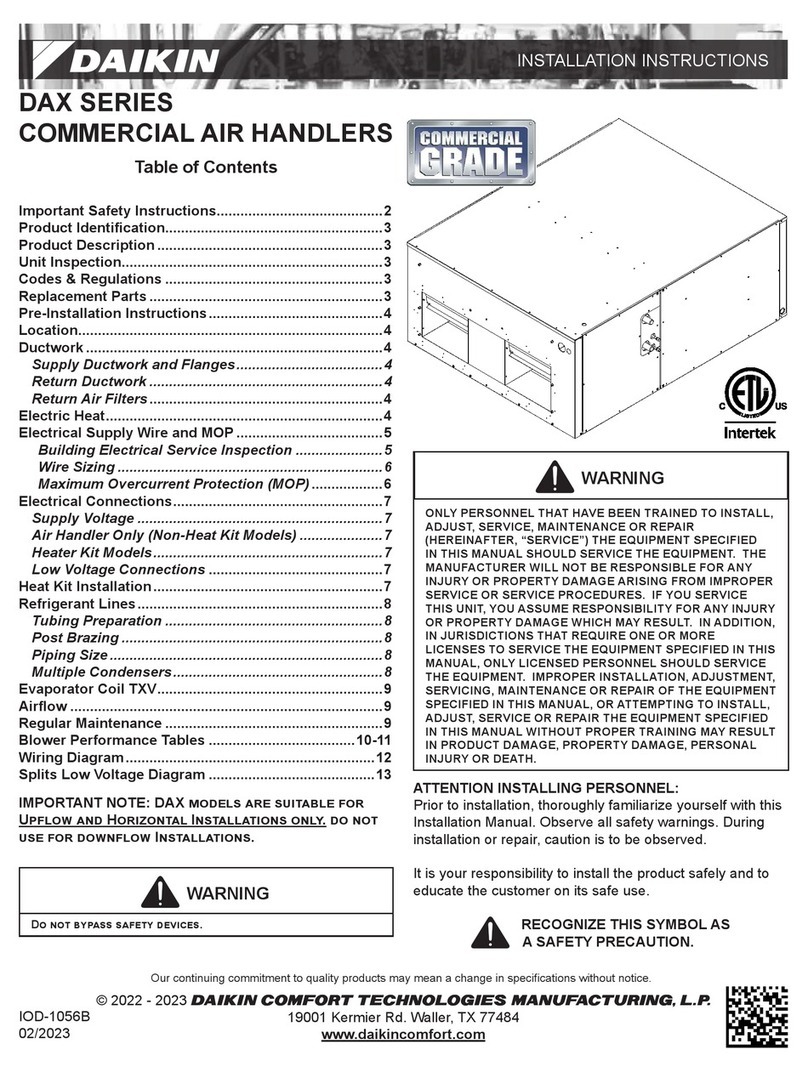
Daikin
Daikin DAX Series installation instructions

VES
VES ecovent mini Operation & maintenance manual
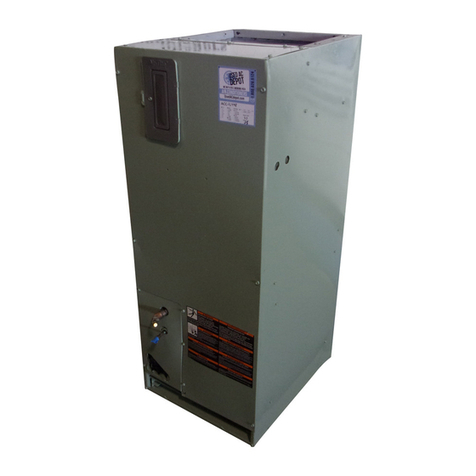
Trane
Trane 4TGB3F18A Installer's guide
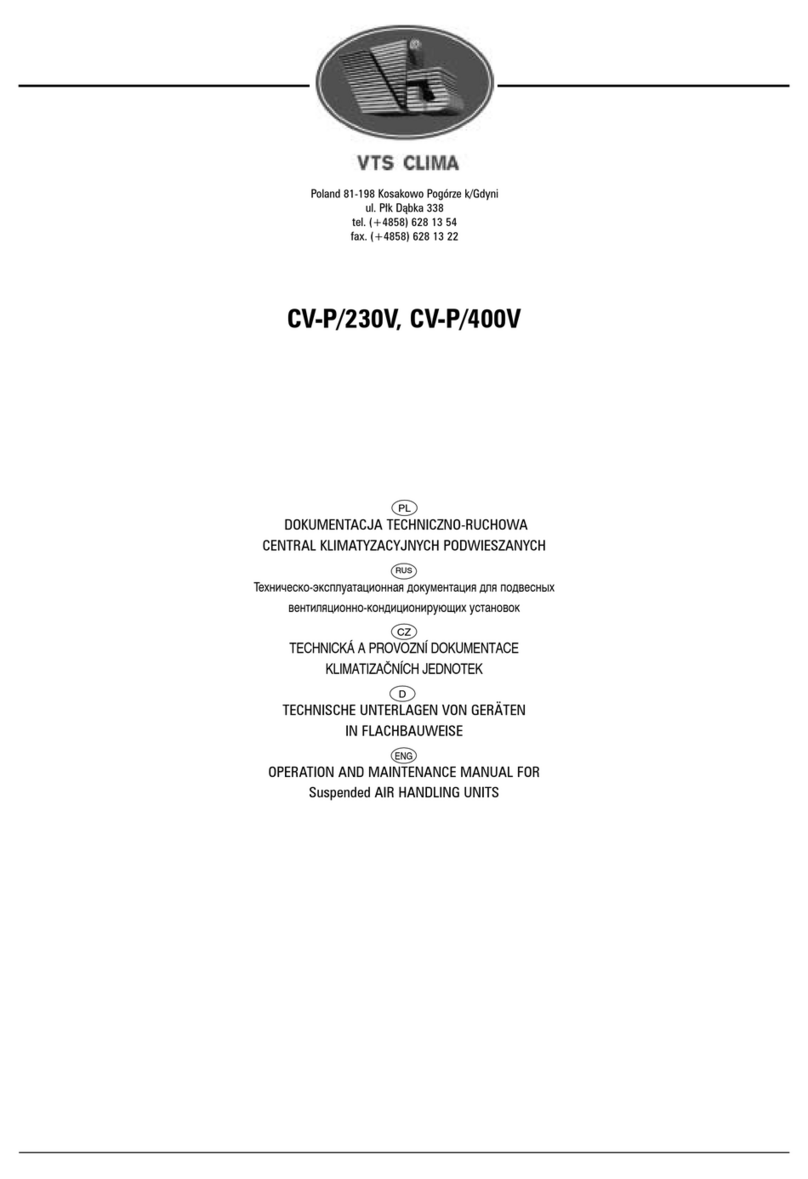
VTS CLIMA
VTS CLIMA CV-P/230V Operation and maintenance manual
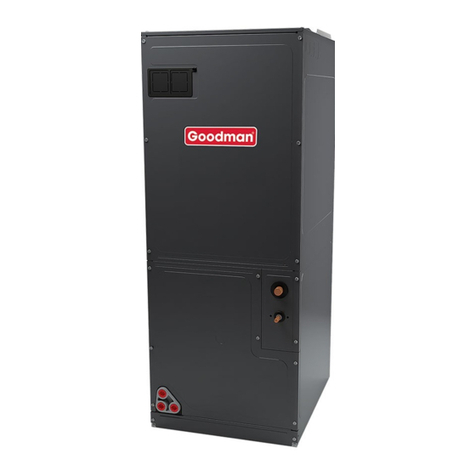
Goodman
Goodman AVPTC42D14 series Installation & operating instructions
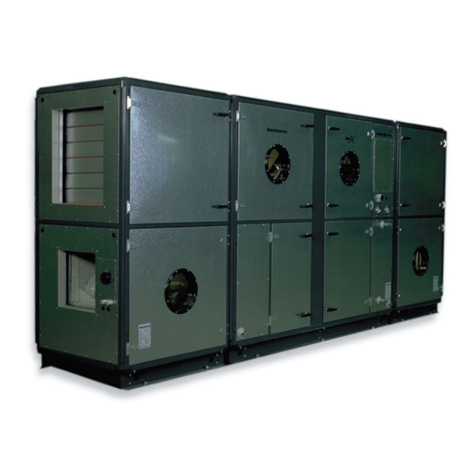
Dantherm
Dantherm DanX 2/4 Service manual
